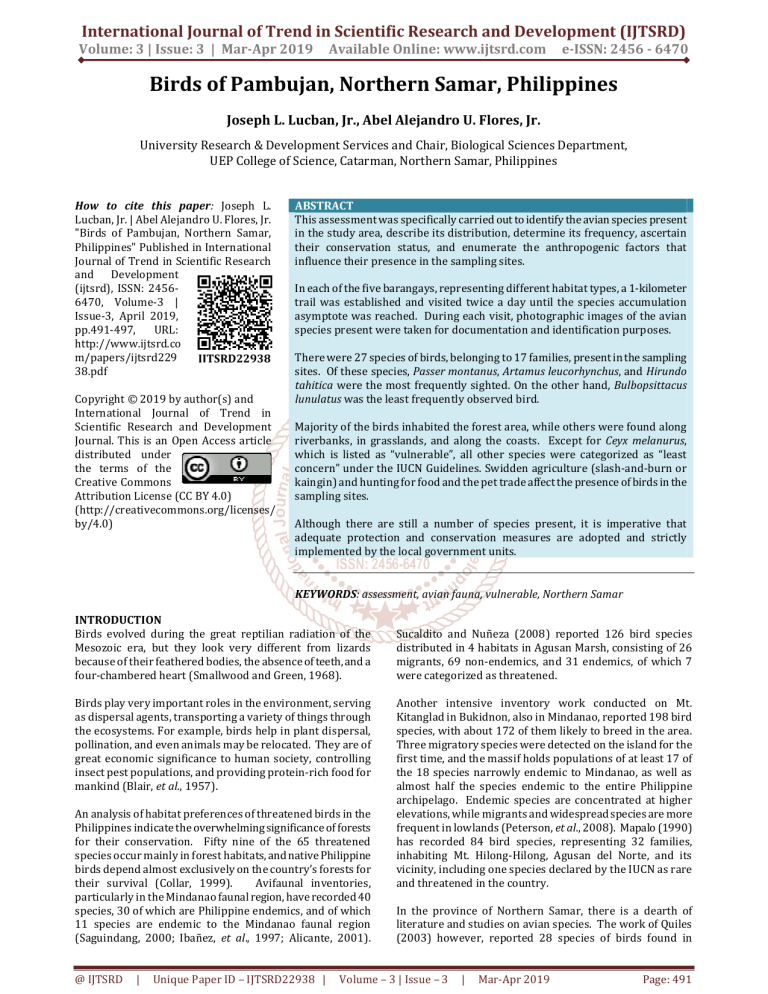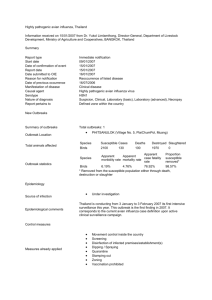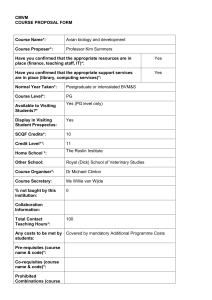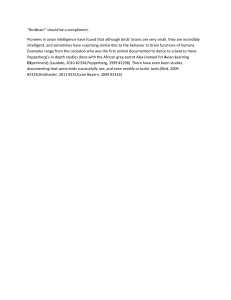
International Journal of Trend in Scientific Research and Development (IJTSRD) Volume: 3 | Issue: 3 | Mar-Apr 2019 Available Online: www.ijtsrd.com e-ISSN: 2456 - 6470 Birds of Pambujan, Northern Samar, Philippines Joseph L. Lucban, Jr., Abel Alejandro U. Flores, Jr. University Research & Development Services and Chair, Biological Sciences Department, UEP College of Science, Catarman, Northern Samar, Philippines How to cite this paper: Joseph L. Lucban, Jr. | Abel Alejandro U. Flores, Jr. "Birds of Pambujan, Northern Samar, Philippines" Published in International Journal of Trend in Scientific Research and Development (ijtsrd), ISSN: 24566470, Volume-3 | Issue-3, April 2019, pp.491-497, URL: http://www.ijtsrd.co m/papers/ijtsrd229 IJTSRD22938 38.pdf Copyright © 2019 by author(s) and International Journal of Trend in Scientific Research and Development Journal. This is an Open Access article distributed under the terms of the Creative Commons Attribution License (CC BY 4.0) (http://creativecommons.org/licenses/ by/4.0) ABSTRACT This assessment was specifically carried out to identify the avian species present in the study area, describe its distribution, determine its frequency, ascertain their conservation status, and enumerate the anthropogenic factors that influence their presence in the sampling sites. In each of the five barangays, representing different habitat types, a 1-kilometer trail was established and visited twice a day until the species accumulation asymptote was reached. During each visit, photographic images of the avian species present were taken for documentation and identification purposes. There were 27 species of birds, belonging to 17 families, present in the sampling sites. Of these species, Passer montanus, Artamus leucorhynchus, and Hirundo tahitica were the most frequently sighted. On the other hand, Bulbopsittacus lunulatus was the least frequently observed bird. Majority of the birds inhabited the forest area, while others were found along riverbanks, in grasslands, and along the coasts. Except for Ceyx melanurus, which is listed as “vulnerable”, all other species were categorized as “least concern” under the IUCN Guidelines. Swidden agriculture (slash-and-burn or kaingin) and hunting for food and the pet trade affect the presence of birds in the sampling sites. Although there are still a number of species present, it is imperative that adequate protection and conservation measures are adopted and strictly implemented by the local government units. KEYWORDS: assessment, avian fauna, vulnerable, Northern Samar INTRODUCTION Birds evolved during the great reptilian radiation of the Mesozoic era, but they look very different from lizards because of their feathered bodies, the absence of teeth, and a four-chambered heart (Smallwood and Green, 1968). Birds play very important roles in the environment, serving as dispersal agents, transporting a variety of things through the ecosystems. For example, birds help in plant dispersal, pollination, and even animals may be relocated. They are of great economic significance to human society, controlling insect pest populations, and providing protein-rich food for mankind (Blair, et al., 1957). An analysis of habitat preferences of threatened birds in the Philippines indicate the overwhelming significance of forests for their conservation. Fifty nine of the 65 threatened species occur mainly in forest habitats, and native Philippine birds depend almost exclusively on the country’s forests for their survival (Collar, 1999). Avifaunal inventories, particularly in the Mindanao faunal region, have recorded 40 species, 30 of which are Philippine endemics, and of which 11 species are endemic to the Mindanao faunal region (Saguindang, 2000; Ibañez, et al., 1997; Alicante, 2001). @ IJTSRD | Unique Paper ID – IJTSRD22938 | Sucaldito and Nuñeza (2008) reported 126 bird species distributed in 4 habitats in Agusan Marsh, consisting of 26 migrants, 69 non-endemics, and 31 endemics, of which 7 were categorized as threatened. Another intensive inventory work conducted on Mt. Kitanglad in Bukidnon, also in Mindanao, reported 198 bird species, with about 172 of them likely to breed in the area. Three migratory species were detected on the island for the first time, and the massif holds populations of at least 17 of the 18 species narrowly endemic to Mindanao, as well as almost half the species endemic to the entire Philippine archipelago. Endemic species are concentrated at higher elevations, while migrants and widespread species are more frequent in lowlands (Peterson, et al., 2008). Mapalo (1990) has recorded 84 bird species, representing 32 families, inhabiting Mt. Hilong-Hilong, Agusan del Norte, and its vicinity, including one species declared by the IUCN as rare and threatened in the country. In the province of Northern Samar, there is a dearth of literature and studies on avian species. The work of Quiles (2003) however, reported 28 species of birds found in Volume – 3 | Issue – 3 | Mar-Apr 2019 Page: 491 International Journal of Trend in Scientific Research and Development (IJTSRD) @ www.ijtsrd.com eISSN: 2456-6470 selected barangays of the municipality of Catubig, totaling about 704 individuals. Onod (2017) has found 15 avian species in the Eco Park of the University of Eastern Philippines, Catarman, Northern Samar. Several studies have been reported that conversion of forested areas into agricultural lands was considered one of the major threats to bird species in various locations in the Philippines. Results reported by Pangcatan (2007) imply the need to conserve the avifauna of Lake Lanao (in Mindanao) and environs through habitat conservation. Sucaldito and Nuñeza (2008) also emphasized that changes in the structural and floristic composition brought about by forest degradation, logging, and hunting were seen as threats to avifaunal diversity in the country. Generally, this research, done in 5 selected barangays of Pambujan, Northern Samar, aimed to document the avian fauna in different habitat types in the municipality, with a view of providing baseline information useful in the formulation of necessary management interventions in the protection and conservation of birds in the study area. Specifically, it intended to: 1) identify the avian species existing in the area; 2) determine its relative frequency; 3) describe its distribution in the area; 4) ascertain the conservation status of the birds identified; and, 5) enumerate anthropogenic activities affecting the existence of birds in the study area. The achievement of the study objectives was limited by the availability of equipment, particularly a camera equipped with telephoto lenses, and the ability of the researcher to spend longer observation hours for security reasons. METHODOLOGY Locale of the Study This study was conducted in Barangay Canjumadal, Barangay Don Pedro de la Cruz, Barangay Ginulgan, Barangay Senonogan, and Barangay Don Sixto Balanquit, Pambujan, Northern Samar, representing different habitat types. Research Design and Sampling Technique This study utilized the descriptive research design, with purposive sampling as the technique employed. Data Gathering Procedure A. Observation of Avifauna The researchers established a 1-km trail in each study area, visiting it twice a day (5:00 to 8:00 AM, and 3:00 to 6:00 PM), using a Sony 2,7- 4,5/5,2-78 DSC-H50 Super Steady Shot to take photos of bird species in the study sites, noting the species and number of individuals found, for identification purposes. Data collection stopped after reaching the species Accumulation Asymptote. Figure1. Map of the Municipality of Pambujan, Northern Samar B. Identification and Classification of Encountered Avian Species Preliminary identification of the avian species was done by the researchers in their natural habitat. Final identification of the species was facilitated through photo documentation, appropriate books, and other available identification guides, particularly the book A Guide to the Birds of the Philippines by Kennedy, et al., (2000) and A Photographic Guide to the Birds of the Philippines by Fisher and Hicks (2000). C. Determination of the Effect of Anthropogenic Activities on Avian Species in the Study Area Data and information on anthropogenic activities in the study area was gathered through a researcher-made interview guide, with 10 respondents in each study site, whose response for each question was noted and interpreted. @ IJTSRD | Unique Paper ID - IJTSRD22938 | Volume – 3 | Issue – 3 | Mar-Apr 2019 Page: 492 International Journal of Trend in Scientific Research and Development (IJTSRD) @ www.ijtsrd.com eISSN: 2456-6470 D. Site Selection The diversity of bird species was monitored through establishing a permanent monitoring plot in each type of ecosystem. The selection of study sites considered diverse ecological needs and diverse behavioral patterns of bird species. It covers a wide range of elevation of land and an adaptable habitat of rice fields, riverbank, coastal areas, and forest areas. In Barangay Canjumadal (riverbank area), 13 species were present. The White-throated Kingfisher, and Collared kingfisher had the highest frequency of 0.8 and a relative frequency of 11.76%. The least frequent were the Little Egret and Whimbrel with a frequency of 0.2 and a relative frequency of 2.94%. RESULTS AND DISCUSSION Presented in Table 1 are the twenty-seven (27) species of birds identified in five sampling areas of the study site, and they belong to 17 families. Each of these families is represented by at least one identified specimen. In the coastal area (Barangay Camparanga), 8 avian species were present. The Common Sandpiper, Pacific Swallow, Gullbilled Tern, Grey-tailed Tattler, Pacific Golden Plover, Lesser Sand Plover, and Whimbrel had the highest frequency of 1.0 and a relative frequency of 13.16%. The least frequent was the Little Egret, with a frequency of 0.6 and a relative frequency of 7.89%. These findings do not necessarily mean that avifauna in the study sites are rare or extinct. Rather, because of their high mobility, and sometimes dense vegetation, especially in the forested areas, the presence of a specimen may have escaped the researchers’ notice. Thus, the number of representative samples of the diverse bird fauna in the locality may have been limited to only these families and representative species. In the Barangay Senonogan (lowland forest), 17 avian species were present. The Philippine Coucal, Eurasian Tree Sparrow, White-breasted Wood Swallow, Asian glossy Starling, and Coleto, had the highest frequency of 1.0, and a relative frequency of 8.19%. The least frequent were the Barred Rail, the Philippine dwarf Kingfisher, Guaiabero, and the Common Moorhen which had a frequency value of 0.4, and a relative frequency of 3.28%. Species Frequency and Relative Frequency The avian species varied in their frequencies and relative frequencies. In Barangay Ginulgan (rice field area), 14 species were present. The Eurasian Tree Sparrow, Intermediate Egret, White breasted wood Swallow, Chestnut Munia, and Pacific Swallow had the highest frequency of 1.0 and a relative frequency of 12.19 %. The least frequent were the Black kite, Pacific Golden Plover, Lesser Sand Plover, and Whimbrel, which had a frequency value of 0.2, with a relative frequency of 2.44%, indicating it had the least number of individuals observed in the study area. In Barangay Don Sixto Balanquit, which represented the highland forest, 17 avian species were present. The Philippine Coucal, Eurasian Tree Sparrow, White-breasted Wood Swallow, Asian Glossy Starling and Coleto had the highest frequency of 1.0 and a relative frequency of 8.62%. The least frequent was the Common Moorhen, which has a frequency of o.2, and a relative frequency of 1.72%, meaning it had the least number of individuals observed in the study area. Table1. Different Avian Species Found in Selected Barangays in Pambujan, Northern Samar SCIENTIFIC NAME ENGLISH NAME FAMILY LOCAL NAME Pycnonotus goiavier Yellow- vented Bulbul Pycnonotidae Palago Centropus viridis Philippine Coucal Cuculidae Saguksuk Passer montanus Eurasian Tree Sparrow Passeridae Tagmaya Egretta intermedia Intermediate Egret Ardeidae Talabong Artamus leucorynchus White-breasted Wood Swallow Artamidae Git-git Gallirallus torquattus Barred Rail Rallidae Tinggaw Oriolus chinensis Black-naped Oriole Oriolidae Tahihilaw Halcyon smyrnensis White-throated Kingfisher Alcedinidae Takray Ceyx melanurus Philippine Dwarf Kingfisher Alcedinidae Takray Aplonis panayensis Asian Glossy Starling Sturnidae Daransiyang Bolbopsittacus lunulatus Guaiabero Psittaculidae Centropus melanops Black-faced Coucal Cuculidae Ubon-ubon Haliastur Indus Brahminy Kite Accipitridae Banog Sarcops calvus Coleto Sturnidae Iling Lonchura atricapilla Chestnut Munia Estrilididae Maya Todiramphus chloris Collared Kingfisher Alcedinidae Takray Gallinula chloropus Common Moorhen Rallidae Tinggaw Milvus migrans Black Kite Accipitridae Banog Corvus enca Slender-billed Crow Corvidae Uwak Actitis hypoleucos Common Sandpiper Scolopacidae Hirundo tahitica Pacific Swallow Hirundinidae Sayaw Egretta garzetta Little Egret Ardeidae Kubo Gelochelion nilotica Gull-billed Tern Laridae Kanaway Heteroscelus brevipes Grey-tailed Tattler Scolopacidae Pluvialis fulva Pacific Golden Plover Charadriidae Charadrius mongolus Lesser Sand Plover Charadriidae Numenius phaeopus Whimbrel Scolopacidae @ IJTSRD | Unique Paper ID - IJTSRD22938 | Volume – 3 | Issue – 3 | Mar-Apr 2019 Page: 493 International Journal of Trend in Scientific Research and Development (IJTSRD) @ www.ijtsrd.com eISSN: 2456-6470 Table 2: Species Frequency and Relative Frequency Species Brgy. Ginulgan (Ricefield) F Rf(%) Brgy. Canjumadal (Riverbank) F Rf(%) Yellow-vented Bulbul 0.8 9.76 Philippine Coucal Eurasian Tree Sparrow 1.0 12.19 Intermediate Egret 1.0 12.19 0.6 White-breasted Wood Swallow 1.0 12.19 Barred Rail 4.4 Black-naped Oriole White-throated Kingfisher 0.8 Philippine dwarf Kingfisher 0.4 Asian glossy Starling Guaiabero Black-faced Coucal Brahminy Kite 0.4 4.88 Coleto Chestnut Munia 1.0 12.19 Collared Kingfisher 0.8 Common Moorhen 0.6 Black Kite 0.2 2.44 Slender-billed Crow Common Sandpiper 0.4 4.88 0.6 Pacific Swallow 1.0 12.19 1.0 Little Egret 0.4 4.88 0.2 Gull-billed Tern Grey-tailed Tattler 0.4 4.88 0.4 Pacific Golden Plover 0.2 2.44 0.4 Lesser sand Plover 0.2 2.44 0.4 Whimbrel 0.2 2.44 0.2 Total 8.2 99.99 6.8 Legend: F = Frequency Rf = Relative frequency Species Distribution of Avian Species Birds inhabit different habitats to survive. Majority of the bird species inhabit the forest areas, with a significant number of species inhabiting the rice fields and the riverbank areas, while the least number of species were found in the coastal area. Of the 27 species identified, 17 species were present in the forests, fourteen (14) were found in the rice field, thirteen (13) species were found the in riverbank, while eight (8) species were found in the coastal habitat. Seven of the identified avian species were present exclusively in the forest habitats. Lonchura malacca was found only in the rice fields, while Gelochelion nilotica was present only in the coastal habitat. Egretta intermedia was observed in the rice fields and riverbanks. Five species were found both in the rice field and forest habitats, another five species were found both in the riverbank and forest habitats, while 7 species were present in the rice field, riverbank, and coastal habitats. Table 3 presents the distribution of the 27 avian species identified among the five habitat types in the study area. @ IJTSRD | Unique Paper ID - IJTSRD22938 | Brgy. Camparanga (Coastal) F Rf(%) Brgy. Senonogan (Forest)* F Rf(%) Brgy.Don Sixto Balanquit (Forest)** F Rf(%) 0.8 1.0 1.0 6.56 8.19 8.19 0.6 1.0 1.0 5.17 8.62 8.62 1.0 0.4 0.8 0.6 0.4 1.0 0.4 0.6 0.8 1.0 8.19 3.28 6.56 4.92 3.28 8.19 3.28 4.92 6.56 8.19 1.0 0.4 0.8 0.8 0.4 1.0 0.4 0.6 0.8 1.0 8.62 3.45 6.90 6.90 3.45 8.62 3.45 5.17 6.90 8.62 0.6 0.4 0.6 0.8 4.92 3.28 4.92 6.56 0.6 0.2 0.4 0.6 5.17 1.72 3.45 5.17 8.82 5.88 11.76 5.88 11.76 8.82 8.82 14.71 2.94 1.0 13.16 1.0 13.16 0.6 7.89 1.0 13.16 5.88 1.0 13.16 5.88 1.0 13.16 5.88 1.0 13.16 2.94 1.0 13.16 99.97 7.6 100 * = Lowland Forest 12.2 99.99 11.6 100 ** = Highland Forest Table3. Species Distribution of Avian Species SPECIES 1 2 3 4 Yellow-vented Bulbul / / Philippine Coucal / Eurasian Tree Sparrow / / Intermediate Egret / / White-breasted Wood Swallow / / Barred Rail / / Black-naped Oriole / White-throated Kingfisher / / Philippine dwarf Kingfisher / / Asian glossy Starling / Guaiabero / Black-faced Coucal / Brahminy Kite / / Coleto / Chestnut Munia / Collared Kingfisher / / Common Moorhen / / Black Kite / / Slender-billed Crow / Common Sandpiper / / / Pacific Swallow / / / Little Egret / / / Gull-billed Tern / Grey-tailed Tattler / / / Pacific Golden Plover / / / Lesser sand Plover / / / Whimbrel / / / TOTAL 14 13 8 17 LEGEND: / = present Volume – 3 | Issue – 3 | Mar-Apr 2019 Page: 494 International Journal of Trend in Scientific Research and Development (IJTSRD) @ www.ijtsrd.com eISSN: 2456-6470 1 = Ricefield (Barangay Ginulgan) 2 = Riverbank (Barangay Canjumadal) 3 = Coastal Area (Barangay Camparanga) 4 = Forest (Barangays Senonogan and Don Sixto Balanquit areas to agricultural lands, and hunting and harvesting of birds for food and trade. Through these continuous anthropogenic disturbances, avian species are forced to transfer to different places. Conservation Status The conservation status of a group of organisms, for instance, a species, indicates whether the group still exists and how likely the group is to become extinct in the near future. Many factors must be taken to account when assessing conservation status. It is not simply the number of individuals remaining, but the overall increase or decrease in the population over time, breeding success rates, and known threats. All the avian species found in the study area were under the category of “Least Concern” and are still far from extinction, except for the Philippine dwarf Kingfisher, which was categorized as “Vulnerable” (IUCN Red List, 2017). Table5. Anthropogenic Activities that Affect the Existence of Avian Species in the Study Area HABITAT ANTHROPOGENIC ACTIVITIES Ricefield No threats Riverbank No threats Coastal areas conversion to residential Coastal area Dumping at coastal areas Illegal logging; Slash and burn agriculture Hunting of birds; Conversion Forest of forested areas to agricultural purposes Of the avian species identified, twelve (12) species were residents, while ten (10) were migrants, with five (5) species endemic to the Philippines. Table 4: Conservation Status of Bird Species in the Study Area Conservation Status Species VU LC Yellow-vented Bulbul / Philippine Coucal / Eurasian Tree Sparrow / Intermediate Egret / White-breasted Wood Swallow / Barred Rail / Black-naped Oriole / White-throated Kingfisher / Philippine Dwarf Kingfisher / Asian Glossy Starling / Guaiabero / Black-faced Coucal / Brahminy Kite / Coleto / Chestnut Munia / Collared Kingfisher / Common Moorhen / Black Kite / Slender-billed Crow / Common Sandpiper / Pacific Swallow / Little Egret / Gull-billed Tern / Grey-tailed Tattler / Pacific Golden Plover / Lesser Sand Plover / Whimbrel / Legend: VU = Vulnerable LC = Least Concern The Anthropogenic Activities that Affect the Existence of Avian Species in the Study Area Data regarding anthropogenic activities was gathered through interviews among 50 local residents selected as respondents, and they reported several anthropogenic factors were, and are still, practiced in the study area. The loss and destruction of habitat is the most serious threat facing many avian species, to include dumping of wastes and conversion of coastal areas to residential zones, cutting of trees, slash-and burning of forests, conversion of forested @ IJTSRD | Unique Paper ID - IJTSRD22938 | CONCLUSION Based on the data gathered, it is concluded that there is a limited number of species present in the community, with the forested areas as the most frequented by birds, while the least frequented habitat was the coastal area. Majority of the avian species mostly inhabit the forest area, while others inhabit the rice fields, riverbanks, and the coastal areas, implying that most avian species need the forested areas for their survival, making it imperative to conserve forests and laws on forest resource exploitation be strictly implemented by concerned government agencies. In terms of conservation status, the species encountered were still of “Least Concern” implying that they are not losing large numbers of individuals, except for Philippine Dwarf Kingfisher, categorized as “Vulnerable”, which implies that the species was no longer common in the study area. The continuous anthropogenic disturbances cause avian fauna to transfer to different places to survive. Results further imply the need to conserve the avifauna through conservation of the habitats. RECOMMENDATIONS The Department of Environment and Natural Resources (DENR), as the primary agency tasked with environmental protection, must conduct seminars in every municipality and barangay to disseminate the laws, rules, and regulations relative to threatened and/or endangered faunal species. The Local Government Units, as well as all other stakeholders should strictly implement the laws against the hunting and trade of bird species to protect and conserve them, and a follow-up study should be conducted involving a larger number of barangays covering the mountainous areas and forests of the province to come up with an in-depth analysis of these resources. LITERATURE CITED [1] Alicante, A. A., 2001. Terrestrial Fauna of Tinago Falls. Mindanao Journal 24:33-59. [2] Blair, W. F., A. P. Blair, P. F.R. Brodkorb, and G. A. Moore, (Eds.) 1957. Vertebrates of the United States. McGraw-Hill, New York. [3] Collar, N. J., A. D. Mallari, and B. R. Jr. Tabaraza, 1999. Threatened Birds of the Philippines. The Haribon Foundation/Birdlife International Red Data Book. Department of Environment and Natural Resources, Environment Agency of Japan and Bookmark, Makati City. 559 pp. Volume – 3 | Issue – 3 | Mar-Apr 2019 Page: 495 International Journal of Trend in Scientific Research and Development (IJTSRD) @ www.ijtsrd.com eISSN: 2456-6470 [4] Fisher, Tim and Nigel Hicks, 2000. A Photographic Guide to Birds of Philippines. Holland Publishers (UK) LtD. [5] Ibañez, J. C., D. S. Afan, G. A. Balanquit, G. L. L. Bueser, and K. M. Galit, 1997. Notes on the Bird Species Diversity of the Highlands of Davao Oriental and Davao Province, Mindanao. Sylva strop. The Philippine Forest Research Journal 1 & 2:103-113. [6] Kennedy, R. S., P. C. Gonzales, E. C. Dickson, H. C. Miranda, Jr. and T. H. Fisher. 2000. A Guide to the Birds of the Philippines. Oxford University Press. United Kingdom. 369 pp. [7] Mapalo, A. M., 1980. Avifauna of Mt. Hilong-Hilong, Agusan Del Norte, Mindanao Island. Mindanao Journal 7:50-50 pp. [8] Onod, Melody B. 2017 “Species Composition of Birds in UEP Forest Reserve, University Town, Northern Samar” Undergraduate Thesis. College of Science. University of Eastern Philippines, University Town, Northern Samar. [9] Pangcatan, N. M. and O. M. Nuñeza, 2007. Bird Diversity in the Northern and Southern Side of Lake Lanao, Marawi, Lanao del Sur, Philippines. [10] Peterson, A. T., T. Brooks, A. Gamauf, J. C. T. Gonzales, N. A. D. Mallari, G. Dutson, S. E. Bush, O. H. Clayton, and R. Fernandez, 2008. The Avifauna of Mt. Kitanglad, Bukidnon Province, Mindanao, Philippines. Fieldiana Zoology 11 4:1-43. White-breasted Wood Swallow Barred Rail Black-Nape Oriole White-throated Kingfisher Philippine Dwarf Kingfisher Asian Glossy Starling [11] Quiles, Venth C. 2003 “An Assessment of Avian Fauna in Selected Barangays of the Municipality of Catubig, Northern Samar” Undergraduate Thesis. College of Science. University of Eastern Philippines, University Town, Northern Samar. [12] Sucaldito, M. P. and O. M. Nuňeza. 2008. Distribution of the Avifauna of Agusan Marsh, Agusan del Sur, Philippines. In: J. H. Primavera (ed) Proceedings of the 1st Scientific Conference on the Agusan Marsh. Philippine Council for Aquatic and Marine Research and Development. UNESCO Jakarta Office. [13] The IUCN Red List of Threatened Species. 2016. http://www.iucnredlist.org/details/6165551/0 Downloaded on 16 November 2017. ACKNOWLEDGMENT The researchers would like to thank the University and College Administration for the equipment used, and the University Research and Development Services Unit for the support and assistance extended. @ IJTSRD | Unique Paper ID - IJTSRD22938 | Guaiabero Black-faced Coucal Brahminy Kite Coleto Volume – 3 | Issue – 3 | Mar-Apr 2019 Page: 496 International Journal of Trend in Scientific Research and Development (IJTSRD) @ www.ijtsrd.com eISSN: 2456-6470 Chestnut Munia Common Moorhen Slender-billed Crow Collared Kingfisher Black kite Pacific Swallow Little Egret Gull-billed Tern Grey-tailed Tattler Pacific Golden Plover Lesser Sand Plover Common Sandpiper Whimbrel @ IJTSRD | Unique Paper ID - IJTSRD22938 | Volume – 3 | Issue – 3 | Mar-Apr 2019 Page: 497



